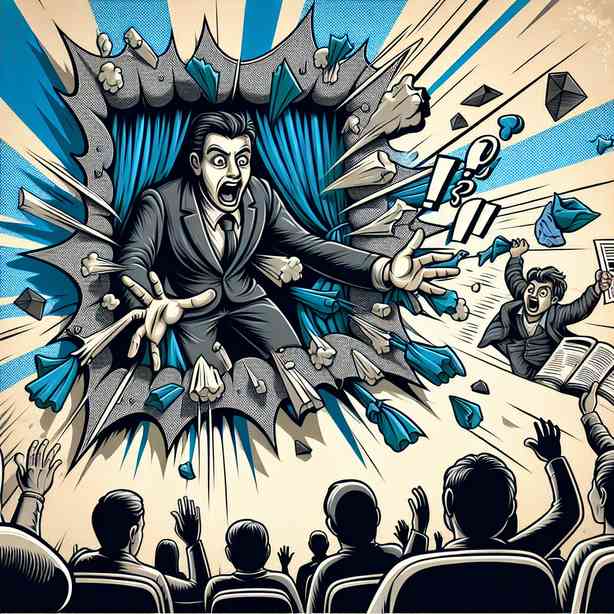
When a character breaks the fourth wall, it creates a unique and engaging moment that can redefine the way an audience interacts with a narrative. This literary and theatrical technique allows a character to step outside the confines of their fictional world, addressing the audience directly. While such moments can evoke laughter, shock, or deeper contemplation, they serve as a bridge between the characters of a story and the viewers, drawing us deeper into the experience.
The term “fourth wall” originates from theater, where the performance takes place on a stage that is surrounded by three walls, with the fourth wall being the imaginary barrier between the performers and the audience. When a character speaks or acknowledges this barrier, they break it, allowing for a unique interaction that can enrich the storytelling. This technique is prevalent not only in theater but also in film, television, literature, and even video games. By breaking the fourth wall, creators can emphasize a point, provide comic relief, or create a sense of intimacy with the audience.
Historically, characters have broken the fourth wall in various ways. One of the most famous literary examples is Mark Twain’s “Adventures of Huckleberry Finn,” where Huck frequently addresses the reader, offering commentary on the events of the story or the moral implications of his actions. This narrative style invites readers to engage more critically with the text, encouraging them to ponder the broader themes of freedom and societal norms. Similarly, in the realm of theater, Shakespeare often employed this technique, particularly through his use of soliloquies and asides, allowing characters like Hamlet to reflect on their innermost thoughts while making the audience a part of the conversation.
In modern media, the breaking of the fourth wall has been popularized by a variety of iconic characters. For instance, the character Deadpool from Marvel Comics is renowned for his meta-commentary and direct engagement with the audience. His awareness of being a fictional character allows for humorous and sophisticated commentary on tropes found within the superhero genre. This engagement not only adds levity but also creates a platform for Deadpool to critique the very medium he inhabits.
Television shows have also successfully used this technique. The sitcom “The Office” is a prime example, using mockumentary style to allow characters to speak directly to the camera, thus cultivating an amusing, conversational atmosphere. This style not only develops character depth but also invites viewers to feel like they are part of the workplace dynamics, making the humor feel more relatable and engaging.
Moreover, in film, works such as “Ferris Bueller’s Day Off” demonstrate the effectiveness of breaking the fourth wall. Ferris, played by Matthew Broderick, frequently speaks directly to the audience, sharing his thoughts and schemes. This not only develops his character’s charm but also allows viewers to feel complicit in his adventures, breaking down the barrier and making the viewing experience more immersive.
In literature, breaking the fourth wall can lead to profound revelations about the nature of storytelling itself. Works like “If on a winter’s night a traveler” by Italo Calvino delve into complex narratives that invite readers to consider their role in the story, questioning traditional narrative structures and expectations. The act of directly addressing the reader prompts a reflection on the relationship between narrative, reality, and fiction, heightening audience engagement.
The technique’s potency lies in its ability to shift perspectives. When a character acknowledges their existence within a fictional universe, it opens a door for exploring themes of authenticity, identity, and reality. This method can serve different purposes across various genres—whether it’s comedy, drama, or even horror. In horror films, a character might break the fourth wall just before a jump scare, leading to a comment that acknowledges the genre’s clichés, which can evoke both laughter and fear.
In video games, breaking the fourth wall can manifest in characters acknowledging player agency or game mechanics. Titles like “The Stanley Parable” exemplify this, as the narration comments on player choices, crafting a unique dynamic where the player feels both in control and questioned about their decisions. This interaction provides a richer experience, as it challenges the typical boundaries of player engagement and narrative.
As we reflect on the significance of breaking the fourth wall, it becomes evident that this technique is not merely for comedic effects. Instead, it serves as a valuable tool for depth and connection in storytelling. It can deepen character development, encourage audience introspection, and offer commentary on societal issues. The nuances this technique presents often encourage viewers, readers, and players to not only consume a story but to participate in it actively.
Looking toward the future, as the boundaries of storytelling continue to evolve with technology and new media, the concept of breaking the fourth wall may further transform. With the rise of virtual reality and interactive storytelling, the relationship between characters and the audience may become even more fluid. Imagine a narrative where characters not only acknowledge their fictional status but also interact with the audience in dynamic ways, creating an even more profound and personalized experience.
In conclusion, the breaking of the fourth wall is a multifaceted technique that enriches storytelling across various media forms. It encourages engagement, reflection, and participation, allowing audiences to become more than mere witnesses but active players in the narrative experience. Whether through laughter or introspection, this technique fosters a deeper connection between the characters and the audience, creating lasting impressions that resonate long after the story ends. As we continue to explore this dynamic interplay in the realms of literature, film, theater, and beyond, the potential for innovative storytelling only grows, promising exciting and thought-provoking experiences for future generations. The next time you encounter a character who breaks that fourth wall, take a moment to appreciate the artistry behind it, and consider the message they aim to convey, for it might just transform your perception of the story itself.


